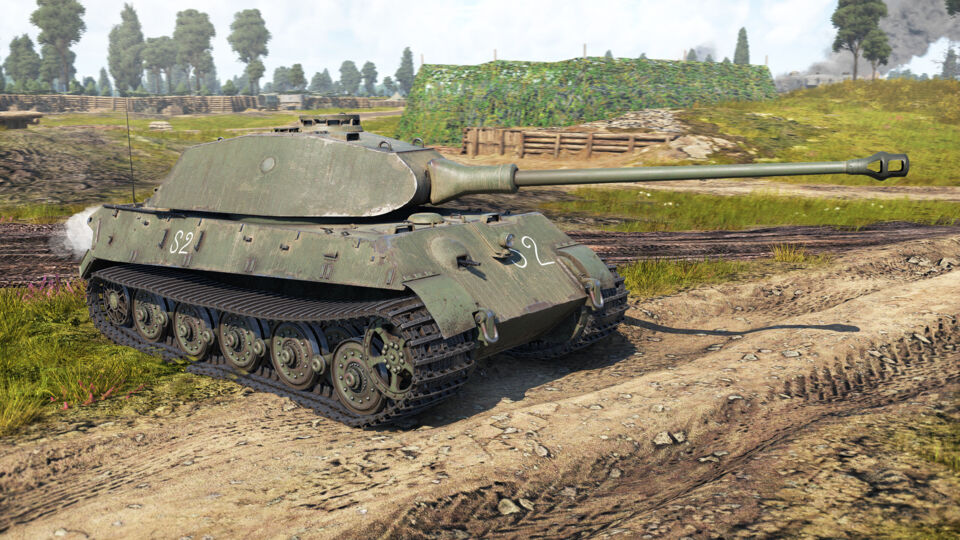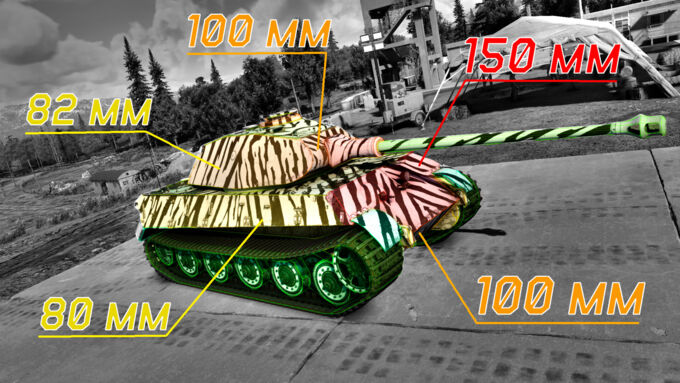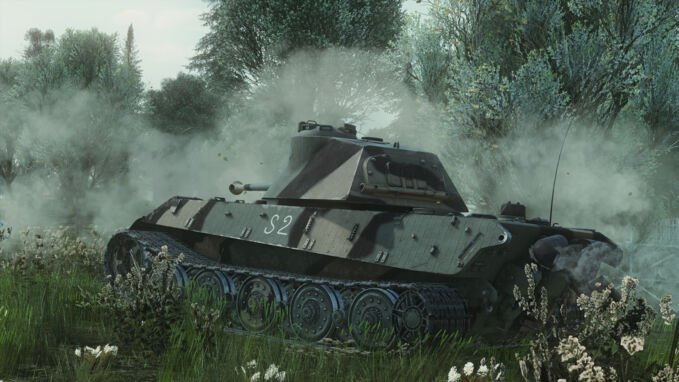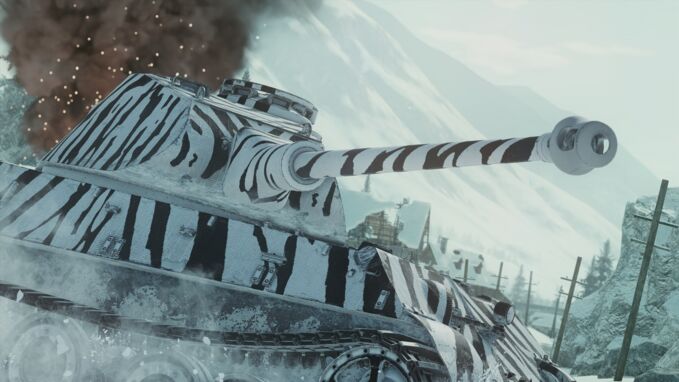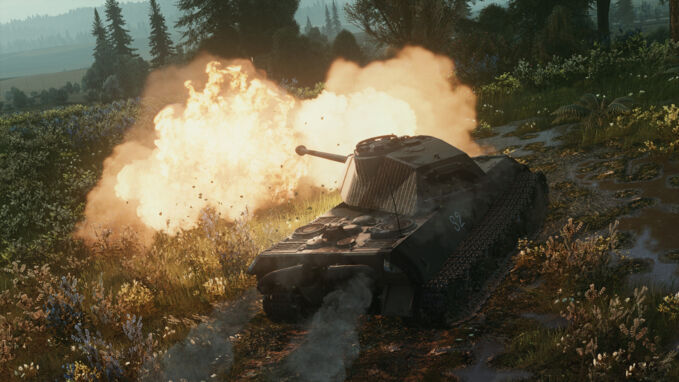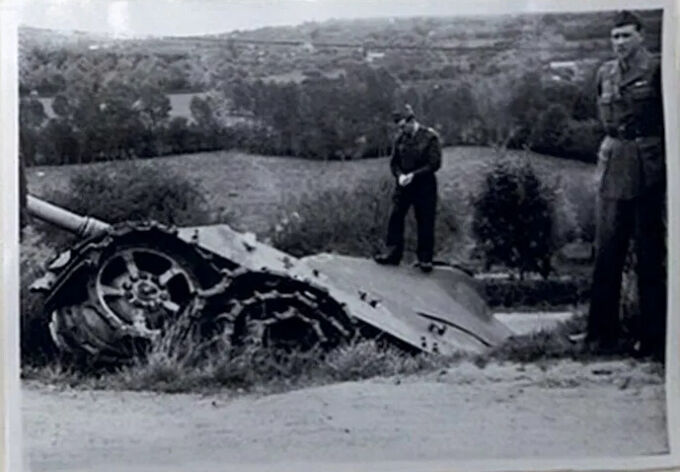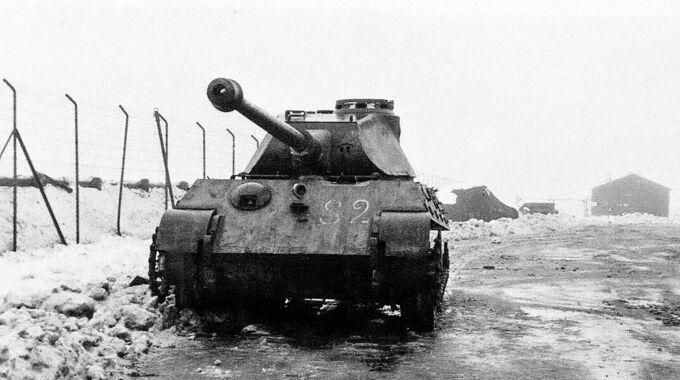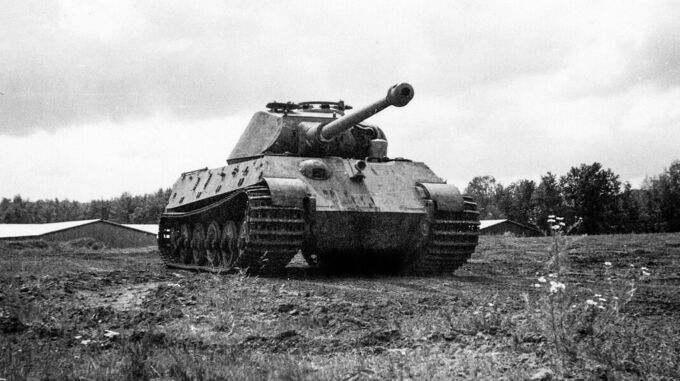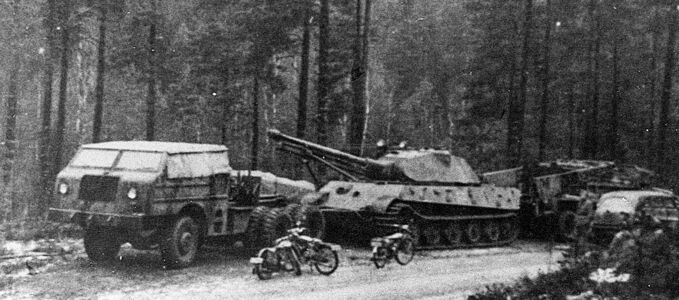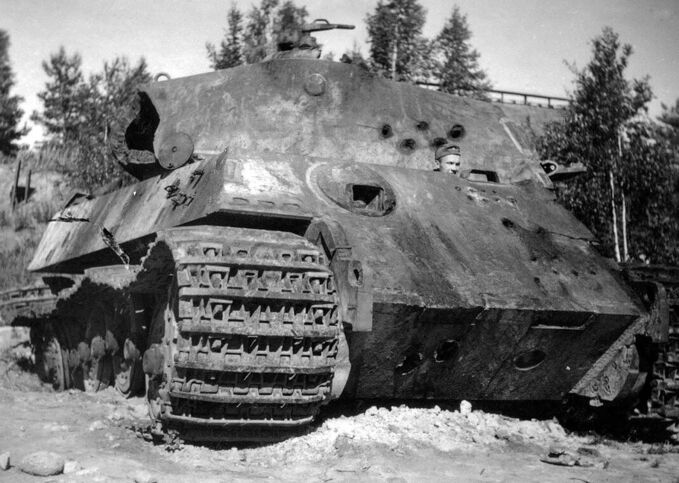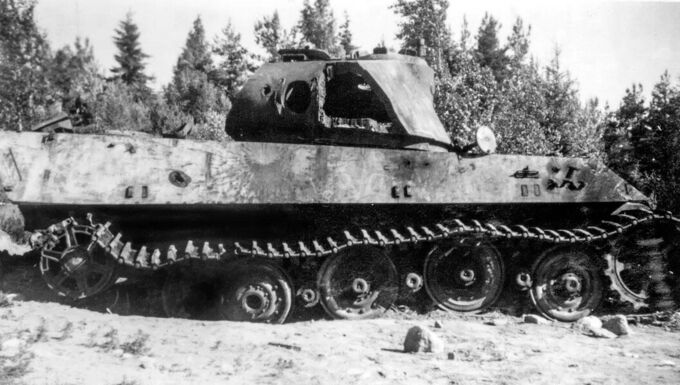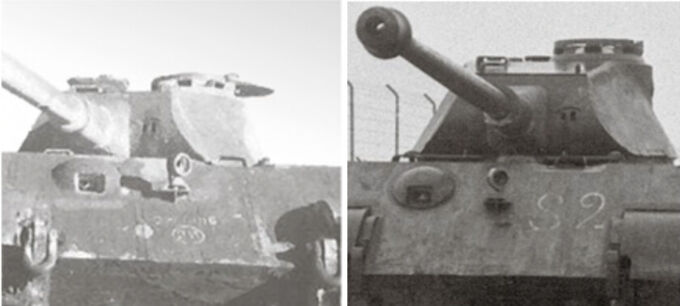The Swedish King Tiger is a unique vehicle in its history and for the Swedish tank tree. It is almost the only heavy tank in the entire tree (KV-1 being the other), and it retains all the strengths of the German tank: strong hull, powerful gun, and good maneuverability. But now its vulnerable turret ring along with overall weak turret protection can be disappointing. Read more about the Kungstiger in this article.
| Pros | Cons |
|---|---|
| Very good front armor protection | Weak turret protection |
| High cannon penetration | Low power-to-weight ratio |
| Adequate reload | Massive size |
| Fast turret rotation | Turret ring is weaker than that of a tank in the german tech tree |
| Spacious internal compartment; crew is separated in two groups | |
| Has smoke launcher |
Survivability and armour
The Kungstiger's armor is its most important asset. The angled upper front 150mm plate can only be penetrated by some HEAT rounds or ATGMs. The lower front 100mm plate is much easier to penetrate, but right behind it is the transmission, which takes all the shrapnel. The 80mm side and rear armour has no vulnerable areas and is positioned at a slight angle, allowing it to angle the tank for additional reinforcement of the frontal armour; the sides themselves protect against autocannons and even some 75mm guns when positioned at a slight angle.
The Achilles' heel of the tank's armor is its turret: the 100mm front has a small area located without slope, because of which it will be frequently penetrated by most enemy guns. Do not rely on the small size of the zone or the possibility of ricocheting: a bouncing shell can hit the roof of the hull and penetrate it with no less devastating effect, and the small vulnerable zone of the front is so well known among the enemies that everyone knows to shoot there.
The sides and rear of the turret also have 80-82mm sloped armor, thus being equal in protection to the hull. The hull and turret tops are pleasing: 40mm plates are sufficient to protect against most aircraft, being vulnerable only to large rockets and large caliber cannons. The turret ring is 60mm thick, unlike its German counterpart, and can even be penetrated by autocannons.
The survivability of the Kungstiger is good: the two-man hull crew sits apart from the other three crew members in the turret. A significant disadvantage of the King Tiger is the location of its ammunition rack: the first 23 rounds are located in the rear of the turret, and a single successful penetration can cause it to explode and the tank to be lost. Another disadvantage is the large silhouette of the Kungstiger. Fortunately, it can be hidden behind the smoke by using smoke grenades.
Mobility
The Swedish heavy tank has the ability to reach a speed of 41-43 km/h in a straight line, which is a good indicator for such a huge machine with a weight of 68 tons. It is pleasant to see the reverse speed of 11 km/h, which allows the vehicle to quickly get out from under fire and play defense, especially in urban areas. The King Tiger's power ratio of 10 hp/t is rather low compared to medium and light tanks, but in comparison to the "heavies", the Kungstiger stands out positively. Maneuverability is also good due to the ability to turn in place, making it much quicker and helpful in urban combat or on uneven terrain.
Armaments
Main armament
The main armament of the Kungstiger is the 88mm Kampfwagenkanone 43 (KwK43). Its -8° elevation down allows you to hide the tank in the creases of the terrain, but the 15° elevation up may not be enough to engage enemies much higher up. Reload speed is nice: 7.5 seconds on the ace crew is faster than some smaller caliber guns and is generally average. The turret rotation speed is also good and is 19° per second with the aced crew. The ammunition of the gun is represented by the following rounds:
- The PzGr 39/43 is an APCBC round. It has excellent armor penetration, good explosive charge (109 grams of TNT equivalent) and high flight velocity, which makes it best suited for the role of the main projectile;
- PzGr 40/43 is an APCR shell. At a distance of 500 meters it penetrates 252 mm of armor, which is only 30 mm better than the APCBC projectile, and at an angle the armor penetration will be less. Its damage after penetration will also be much worse. Because of these factors the projectile is rarely useful;
- Hl.Gr 39 is a HEAT round. It has low penetration, which does not decrease with distance, and low velocity. It is recommended against lightly armored vehicles, but otherwise is useless;
- Sprgr — HE projectile. Penetrates only 19mm of armor at close range and is generally of little interest given that tank has HEAT rounds.
Machine gun
The machine gun armament of the Kungstiger is represented by only one 7.92 mm MG34 machine gun with a total ammunition of 3000 rounds and a magazine of 150 rounds. It is enough to destroy some obstacles on the way or to fight against unarmored vehicles.
Usage in battles
Thanks to its powerful cannon, Kungstiger is well suited for the role of a sniper, supporting the advancing allies or preventing enemy attacks in some directions. To do this, you need to find a position with a good view, keep the tank pointed at the enemy, and look around in case the enemy is flanking you. Excellent frontal armor of the hull will protect the tank from most enemy shells, and only the turret is worth worrying about. The most dangerous opponents for this role will be vehicles with large-caliber HE shells or HEAT, armor penetration of which does not decrease with distance. Those are, for example 2S3M, Pbv 501 or Ru 251.
In close combat, the Kungstiger can face a number of difficulties: light tanks will quickly outflank it, and unlike some tank destroyers, it cannot stand in a straight line to play off its armor, as its turret is very vulnerable. In addition, light tanks will often be the first to arrive at such positions and simply attack the Swedish tank while it has to stop and fire. At close range, the King Tiger is better off relying on its allies to protect its flank, and itself moving constantly. Though its better to be cautious and allow the enemy to expose themselves first.
When hiding behind cover, it is important to know whether the cover can be penetrated or not and what protection it provides, taking into account the large size of the tank, because of which it will not be possible to cover it completely in some places. It is also important to angle the hull to increase your own defense, but never turn the front of the turret away from the enemy: then the enemy shell will penetrate the turret through its even thinner side. When in an ambush behind a cover, a corner of a building, or a hill, it is better to wait for the enemy to show their vulnerable spots, come out, take a shot, and hide back behind cover, taking advantage of the quick rear speed, then reload, and repeat the process.
History
King Tiger trials in Sweden
Between 1946 and 1947, Swedish military attachés were busy all over Europe looking for German equipment for various tests involving them. One of these countries was France, where the Swedes wanted to find a Panther and some kind of heavy tank. Pz.Kpfw V Panther Ausf.A was found in a tank depot near Versailles, it was given for free, and now this very machine can be found in the Panzermuseum in Münster. It was more difficult to get a heavy tank: a Panzerkampfwagen VI Ausf. B, "Tiger II" was inspected near Vimoutiers on October 4, 1946, but the Swedish commission was not satisfied with its condition: it was lying in a ditch and completely burnt out inside. There was no way to bring it to Sweden in this condition and get any benefit from its trials, so the French promised to find a new machine.
Only in August 1947 the French found a new "King Tiger" in the city of Guyenne, south of Paris. The Swedes were satisfied and the tank was delivered to Stockholm by Skandinavisk Express. The transportation of the "King Tiger" first through France by land and then by sea to Sweden took several months, and it arrived there only on November 27. In December it was delivered to the P 4 tank unit in Sjövde, where it remained in the workshop for several months. When it was finally prepared for testing, one of the officers found an unexploded German grenade in the engine compartment, which was removed without any problems and disarmed with a small explosive charge. The engine was then reassembled and inspected, and the tank was driven around the workshop for the first time before the test.
In 1948, the "King Tiger" began cross-country trials in Sjövde, during which the swing arm of one of the outermost wheels broke on a steep turn in loose sand in the field in front of the workshop. It was welded, but the ability to turn the tank was lost. As it was impossible to carry out further driving tests, the military decided to transfer the tank to the Army Test Centre in Karlsborg, where the FMV test site is located today.
Planning the transport of the 69-ton tank was quite a challenge for the logisticians: transporting it across the bridge over the canal near Karlsborg was impossible due to its weight, so it was first sent by rail to Finnerödja, from where it had to be transported another 60 kilometers through wooded and hilly terrain. For this purpose a whole convoy was organized, in which the tank was carried by M26 Dragon Wagon and M4A4 Sherman. The supporting vehicles included an m/46 truck, a 10-ton tractor, a 5-ton tanker, two cars and four motorcycles. All transportation took place from 10th to 15th November.
Upon arrival at the range, the Swedes decided to use the King Tiger as a target for testing various projectiles. The engine, transmission and turret were removed, and from 1948 to 1952 it was fired with a wide range of weapons, including sub-caliber shells for the Pvkv m/43 and rockets from the Granatgevär m/48 Carl Gustaf anti-tank grenade launcher. After the tests the hull was scrapped and the turret became a target for the new Strv 81 tanks. The gun was shipped to Bofors and tested by the company until the 1960s, and eventually scrapped in the 1990s. The transmission and engine survived and can be found in the Arsenalen Museum.
Identification
Until more information became available, there were three theories about the tank: one suggested that it was one of the S.Pz.Abt. 503, which was in France during Operation Overlord in 1944 and was abandoned with the Allied advance inland. However, it may be discarded due to the presence of late tracks on the tank. Another suggests that it belonged to s.Pz.Abt. 506, which was never in France, but the tank somehow found its way to Guyenne from Germany or the Netherlands after the war. It could also be discarded because of the presence of a specific engine exhaust, which was not used on the King Tigers when s.Pz.Abt. 506 was in combat. Finally, the last theory, which turned out to be true, is that it was one of the Kummersdorf test range tanks. It helps to identify a number of features that are characteristic only for early tanks: early turret, which was installed only on 50 tanks, snorkel, which was installed only on 11 pre-production tanks, missing turret ring protection, which was not installed on 17 tanks, and at least 5 other minor details. On the other hand the tank has late tracks and an exhaust flame arrester, which would not have been installed before January 1945.
All this narrows it down to one vehicle: the "King Tiger" number 211, but how it ended up in France remains a mystery. The tank itself took part in several Kummersdorf trials, and winter trials were held in Austria, in St. Johann. On the pictures of the tank from there you can see the features, which are also unique for the Swedish Tiger. So it went from Kummersdorf near Berlin to Austria, and after the war to the German tank gathering point in France.
Sources
- The Swedish King Tiger — A very good article from the swedish tank community with a lot of interesting details about the swedish King Tiger.
- The Swedish Königstiger — another article from tank-enyclopedia, but with somewhat outdated information.
- Official announcement
- Screenshots: FULZY_NYAN, GiMei
